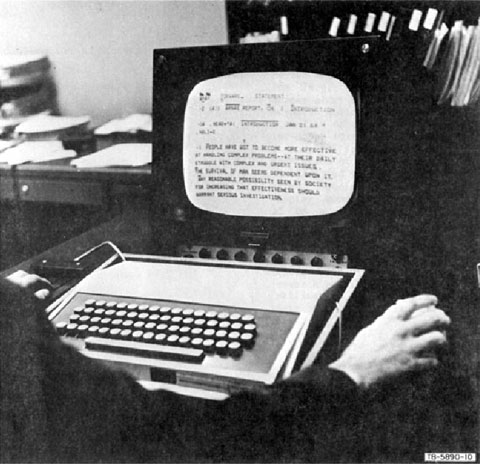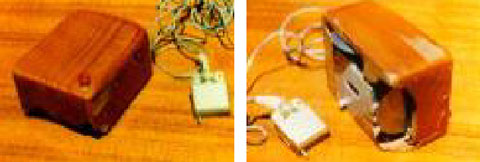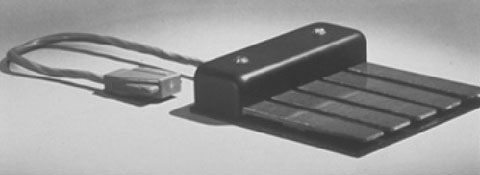The Augmentation Research Center at Stanford Research Institute (SRI-ARC) has already been mentioned in the previous chapter about hypertext. Now the system NLS (cf. 3.1.3) will be examined from the perspective of interaction techniques. Doug Engelbart’s long term objective is the augmentation of human intellect. His fundamental research lead especially to the invention of the mouse in 1963. Windows, interactive text editing, the five-finger chording keyset input device, and video conferencing are other development projects at SRI.
3.1.3 NLS/Augment
in Vision and Reality of Hypertext and Graphical User Interfaces
Doug Engelbart and his team at SRI did a lot of research work on the design of in- and output devices. The main design principle was to continuously improve the physical and mental relation between human and the machine. The term bootstrapping is coined by Engelbart to describe, that all systems are not only developed but also used extensively by the members of the Augmentation Research Center (ARC). All source code, reports, internal documentation, e-mails and printed letters at ARC are written with NLS in order to discover improvements for the next generation of the system. The text editing capabilities of NLS have already been discussed in 2.1.3 NLS/Augment (p. 16).
By the end of the 1960s the output screen is a conventional TV monitor (cf. Fig. 3.2). An inhouse cable TV network is used to deliver the signal to the offices of the ARC members. The original proposed 17" computer monitors would cost about $15,000 to $20,000. Too much for ARC’s budget. Smaller 5" monitors are affordable but not sufficient for an ergonomically designed computer workplace. That’s why Doug Engelbart chose the indirect way. The time-shared mainframe computer generates images on a couple of 5" raster-scan displays. A high-quality video camera is mounted in front of each screen, takes the picture, amplifies the signal and transmits it to the TV sets in the offices [Engelbart 88, p. 197].
Furthermore this detour offers the advantage to experiment with the video signal. A simple inversion leads for the first time to a positive display of text on screen. Equipment to mix different channels was also reasonably cheap. The famous NLS demo at Fall Joint Computer Conference December 1968 makes frequent use of split screens and overlay effects.

Fig. 3.2 shows Engelbart’s NLS workstation around 1967. With his right hand he holds a mouse, and under his left hand is a five-finger chording keyset. We will look now at these two instruments for user input. [better scan: ChronoLink 1968]
The evaluation of graphical input devices for text editing compared the light pen, with joysticks, and with a new development called the mouse. Bill English describes the experiments in Selection Techniques for Text Manipulation [English/Engelbart/Berman 67]. The statistical results indicate that the mouse is faster and more accurate than any other device. The original mouse is a little wooden box that «is constructed from two potentiometers, mounted orthogonally, each of which has a wheel attached to its shaft» [Ibid., 2d2]. The motion of the mouse on the table is interpreted as cursor movements on the display. A button on top is used for the select function.

Fig. 3.3 The first wooden mouse, invented by Doug Engelbart and Bill English at SRI in 1963
Like the mouse the five-finger chording keyset is also invented at SRI-ARC. It is usually operated with the less dominant hand. The five keys can be pressed not only one by one, but like chords on a piano keyboard several at the same moment. These 31 possible combinations are mapped to the letters of the alphabet. The thumb alone produces an ‘a’, the index finger a ‘b’, thumb and index finger together produce a ‘c’, middle finger a ‘d’, middle finger and thumb an ‘e’ and so on. In order to generate more than just the lower case letters the mapping is systematized to five cases. This is described in A Research Center for Augmenting Human Intellect [Engelbart/English 68, 3b5]. The first case contains lower case letters, the second has the upper case letters. The thirst and fourth case contains numbers and punctuation. Finally the fifth case is reserved for control functions like backspace or underline. To change between the cases a particular chord has to be pressed to change the mode to the control case from where the other four cases can be reached.

Fig 3.4 The Five-Finger Chording Keyset (zoom on 99% invisible)
The chording keyset is an equivalent alternative to the qwerty keyboard. To the NLS system it is the same whether a character is generated by the standard keyboard or by the chording keyset.
The advantage of the chording keyset becomes clear if we consider the motion of the hands during the usage of a mouse-equipped computer. The hands travel back and forth between the keyboard to enter some text and the mouse to locate a new cursor position. The combination of mouse and chording keyset provides a two-handed, higher-speed option. The to and fro of the hands does not happen that often anymore. Words and short phrases can be entered without moving the hands away from mouse and keyset. Engelbart explains, [Engelbart 88, p. 220]
[We] aren’t limited to doing things sequentially, but can do things with both hands, concurrently. This stimulated the chord-keyset option.
Longer text passages can of course be entered with the standard keyboard.
Moreover the chording keyset is best suited for NLS’ command architecture. All commands are 2-letter combinations. The first letter specifies the operation, the second specifies the type of the operand. For example the input ‘CW’ stands for copy word, whereas ‘CS’ is the copy statement command. The following click with the mouse selects the target of the operation, in our example either the word or the statement [Friedewald 99, p. 415].
For the members of ARC the collection of input devices has turned out to be very useful and efficient. Once they are learned they can hardly be surpassed by other input methods. But especially the chording keyset is a high threshold for the average user. The invisible modes and artificial mappings are hard to learn and to remember. Thierry Bardini describes the bewilderment of the outside user in Bootstrapping – Douglas Engelbart, Coevolution, and the Origins of Personal Computing [Bardini 2000, p. 145]
Because of the highly original nature of the system, some of the practices also were unique to the ARC community and tended to separate that community from outsiders. Some astonished visitors reported that the ARC members had strange codes or habits, such as being able to communicate in a “weird” sign language. Some staff members occasionally communicated across the distance of the room by showing the fingers position of a specific chord entry on the keyset.
![]() For a free PDF version of Vision and Reality of Hypertext and Graphical User Interfaces (122 pages), send an e-mail to:
For a free PDF version of Vision and Reality of Hypertext and Graphical User Interfaces (122 pages), send an e-mail to:
![]() mprove@acm.org I’ll usually respond within 12 hours. [privacy policy]
mprove@acm.org I’ll usually respond within 12 hours. [privacy policy]
à propos
- Chapter 2.1.3 NLS/Augment
- Doug Engelbart Institute Videos
- Belinda Barnet: Hypertext before the Web – or, What the Web Could Have Been In: Niels Brügger, Ian Milligan (eds): The SAGE Handbook of Web History
- Of Mice and Men, 99% invisible #149 :: with rare photos
- Engelbart 1963: Conceptual Framework for the Augmentation of Mans Intellect
- Engelbart 1968: Study For The Development Of Human Intellect Augmentation Techniques
- Engelbart 1970: Advanced Intellect - Augmentation Techniques
- Engelbart 1970: Computer - Augmented Management - System Research And Development Of Augmentation Facility
- 1970: COMPUTER-AUGMENTED MANAGEMENT-SYSTEM RESEARCH AND DEVELOPMENT OF AUGMENTATION FACILITY
- 1992 Bootstrap Seminar 03/92 Day 1 #3